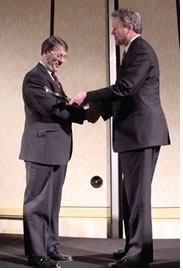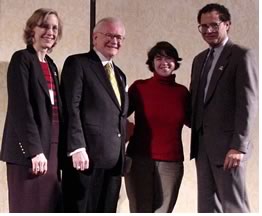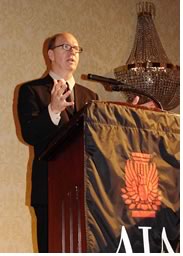
AIA allies liven up the midday meal for Grassroots participants
 The
noon activities began with AIA Treasurer Douglas L. Steidl, FAIA, presenting
a presidential citation to 2000–2001 Treasurer Harry Rutledge, FAIA.
"I like to call him the savior of the AIA," Steidl said of his
predecessor in recognition of Rutledge's efforts to put the AIA back on
track to a balanced budget. The commendation also cited Rutledge's groundbreaking
leadership in reestablishing the AIA's financial stability.
The
noon activities began with AIA Treasurer Douglas L. Steidl, FAIA, presenting
a presidential citation to 2000–2001 Treasurer Harry Rutledge, FAIA.
"I like to call him the savior of the AIA," Steidl said of his
predecessor in recognition of Rutledge's efforts to put the AIA back on
track to a balanced budget. The commendation also cited Rutledge's groundbreaking
leadership in reestablishing the AIA's financial stability.
"We're heading in the right direction," Rutledge said in accepting
the citation. "Now we can concentrate on what we're supposed to be
concentrating on, and that's creating great architecture."
Convention is coming!
Robin Ellerthorpe, FAIA, chair of the AIA 2002 Convention Advisory Committee,
and Carolinas Convention Committee Cochair Bobby Patterson, AIA, teamed
up to present a tempting taste of the upcoming national convention, to
be held this year, May 9 to 11, in Charlotte. Among the attractions Patterson
offered are the host chapter party May 10, "A Carolinas Expedition,"
40 tours in both North and South Carolina, and the fact that the two states
boast a total of 750 golf courses.
 The
AAF supports local programs
The
AAF supports local programs
Harold L. Adams, FAIA, chair of the American Architectural Foundation
(AAF) Board of Regents, presented the recipients of the AAF's Accent on
Architecture Grants, which support local initiatives that promote an increased
awareness, appreciation, and understanding of the need for public involvement
in the design process. In this, the 60th anniversary of the Foundation,
"we need advocates," Adams said. He acknowledged one in particular,
the CNA Insurance Companies and Victor O. Schinnerer & Company, Inc.,
the sponsors of the 2002 grants program. Schinnerer Vice President Lorna
Parsons and Assistant Vice President Frank Musica, Assoc. AIA joined AAF
Acting President Melissa Houghton onstage to acknowledge the grant recipients.
This year's recipients and their projects are:
• AIA Memphis: Integrating Design Education into K-12 Critical Thinking
Learning Experience
• Allegheny Ridge Corporation: Historic District Impact
• Chicago Architecture Foundation: Architecture for Educators
• Community Design Center of Pittsburgh: Renovation Information Network
• Council of Community Services, Roanoke, Va.: Developing Urban Neighborhoods:
Integrating Design and Sustainable Neighborhoods
• Heritage Preservation: Inside Outdoor Sculpture: Resource Guide
and Teacher/Leader Workshops
• Little Tokyo Service Center Community Development Corporation,
Los Angeles: Preserving Ethnic Historic Sites
• Shaw EcoVillage Project, Washington, D.C.: Safe Routes for Shaw
• South Florida Chapter, Associated General Contractors of America:
Build Up! for Miami/Dade fifth graders
• Town of Fletcher, N.C.: Design of Fletcher Town Hall: By the People,
For the People
• Town of Mooresville, N.C.: Cascade Community Design Workshop
• University of Wyoming, Department of Civil and Architectural Engineering:
Fostering Community through Design of Public Space
• Urban Design Center of Northeast Ohio: Design Review Board Training
Program
• Youngstown State University, Public Service Institute: The Power
of Our Downtowns 2002.
 The
AIA/McGraw-Hill Alliance
The
AIA/McGraw-Hill Alliance
AIA President Gordon Chong, FAIA, in turn recognized AIA Strategic Partner
McGraw-Hill Construction Information Group President Norbert Young, FAIA,
and introduced Architectural Record
Editor in Chief Robert A. Ivy, FAIA.
This has been an amazing and challenging past year, Ivy told the audience, making reference to the twin towers terrorist strike, which he witnessed from only a few blocks away. "We walked through a door we didn't choose to walk through, and will never be the same," he said.
Among the changes is a newfound respect for buildings. The built fabric really matters to the public now, Ivy said. And Architectural Record is there to inform the discussion of, for instance, the discussion of a memorial to that day.
"This is a moment that design can be heard," he concluded. "Let's take this opportunity."
Copyright 2002 The American Institute of Architects. All rights reserved.
![]()
|
|
|